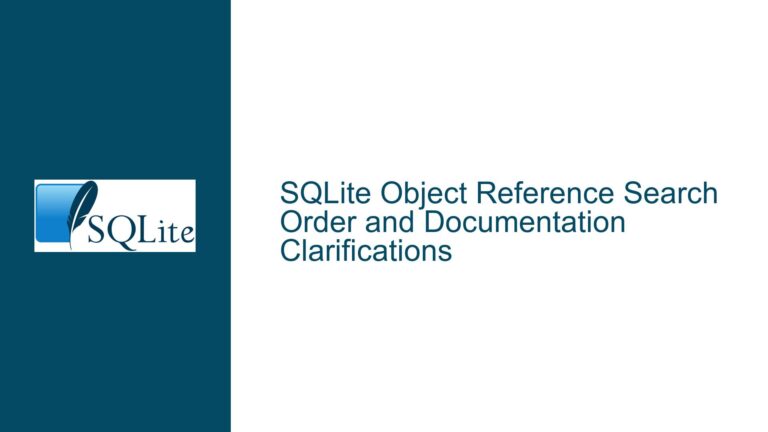Resolving Foreign Key Constraint Errors in SQLite Table Creation
Understanding Foreign Key Constraints and Schema Syntax in SQLite
1. Foreign Key Declaration Syntax and Schema Design Errors
The core issue revolves around improper declaration of foreign key constraints within the CREATE TABLE statement for the LIGNES table. SQLite requires strict adherence to syntax rules when defining columns, data types, and constraints. In the original schema, foreign key constraints were declared inline with column definitions but lacked proper separation from column declarations. For example:
CREATE TABLE LIGNES (
[ID] INTEGER PRIMARY KEY,
...,
[FACTUREID] INTEGER,
FOREIGN KEY (FACTUREID) REFERENCES FACTURES(ID), -- Syntax issue here
[CLIENTID] INTEGER,
FOREIGN KEY (CLIENTID) REFERENCES CLIENTS(ID)
);
The comma placement after FACTUREID INTEGER and before the foreign key declaration creates ambiguity. SQLite interprets this as an attempt to define a new column or constraint without properly terminating the prior column definition. This violates the CREATE TABLE syntax rules, which require:
- Inline constraints (e.g.,
NOT NULL,UNIQUE) to be declared immediately after the column name and data type, without commas. - Out-of-line constraints (e.g., composite foreign keys, table-level
CHECKclauses) to be declared after all columns, separated by commas.
The corrected approach separates column definitions from foreign key constraints:
CREATE TABLE LIGNES (
ID INTEGER PRIMARY KEY,
...,
FACTUREID INTEGER,
CLIENTID INTEGER,
FOREIGN KEY (FACTUREID) REFERENCES FACTURES(ID),
FOREIGN KEY (CLIENTID) REFERENCES CLIENTS(ID)
);
This ensures the parser recognizes FACTUREID and CLIENTID as columns first, followed by explicit foreign key constraints.
2. Data Type Misuse and Version Compatibility Issues
SQLite’s flexible typing system ("type affinity") allows columns to store any data type, but schema declarations still require careful handling:
VARCHAR(n)vs.TEXT: SQLite treatsVARCHAR(n)as equivalent toTEXT, ignoring the length constraint. UsingTEXTis more idiomatic.- Invalid
DATEType: SQLite lacks a nativeDATEtype. Declaring a column asDATEwill assign itNUMERICaffinity, but storing dates asTEXT(ISO 8601 strings) orINTEGER(Unix timestamps) is recommended. - Legacy SQLite Versions: Version 3.6.7 (released in 2009) predates critical foreign key enforcement features. Foreign key support was added in 3.6.19 (2010) but disabled by default until 3.7.17 (2013). Older versions may ignore foreign key constraints entirely unless explicitly enabled via
PRAGMA foreign_keys = ON;.
The original schema’s use of VARCHAR and DATE types, while not directly causing the foreign key error, introduced unnecessary complexity. Modernizing the schema to use TEXT and removing DATE avoids confusion:
CREATE TABLE FACTURES (
ID INTEGER PRIMARY KEY,
NUMERO TEXT,
DATE TEXT, -- Now stored as TEXT
DEJAPAYE TEXT,
CLIENTID INTEGER NOT NULL,
FOREIGN KEY (CLIENTID) REFERENCES CLIENTS(ID)
);
3. Enforcing Referential Integrity and Schema Validation
Even with correct syntax, foreign key constraints may fail silently due to:
- Missing
NOT NULLDeclarations: Columns likeCLIENTIDinFACTURESorLIGNESshould prohibitNULLvalues if every invoice must link to a client. WithoutNOT NULL, rows could reference invalid or placeholder clients. - Disabled Foreign Key Enforcement: In SQLite versions where foreign keys are supported, the
PRAGMA foreign_keyscommand must be executed at the start of every connection to enable constraint checks. - Circular References: While not present in this schema, circular foreign key dependencies (e.g.,
TABLE AreferencesTABLE B, which referencesTABLE A) can cause insertion errors unless deferred constraints are used.
The revised schema addresses these with:
CREATE TABLE LIGNES (
ID INTEGER PRIMARY KEY,
...,
FACTUREID INTEGER NOT NULL,
CLIENTID INTEGER NOT NULL,
FOREIGN KEY (FACTUREID) REFERENCES FACTURES(ID),
FOREIGN KEY (CLIENTID) REFERENCES CLIENTS(ID)
);
Adding NOT NULL ensures referential integrity at the column level, while explicit foreign key constraints enforce relationships at the table level.
Diagnosing and Correcting Foreign Key Errors
Step 1: Verify SQLite Version and Foreign Key Support
Check SQLite Version:
SELECT sqlite_version();If the version is below 3.6.19, foreign key constraints are unsupported. Upgrade to at least 3.37.0 (2021) for full feature support.
Enable Foreign Key Enforcement:
PRAGMA foreign_keys = ON;Execute this command at the start of every database connection.
Step 2: Validate Schema Syntax
Use tools like SQLiteSpy or the command-line shell to validate CREATE TABLE statements. For the LIGNES table:
Incorrect:
CREATE TABLE LIGNES (
ID INTEGER PRIMARY KEY,
FACTUREID INTEGER, FOREIGN KEY (FACTUREID) REFERENCES FACTURES(ID), -- Comma misuse
CLIENTID INTEGER, FOREIGN KEY (CLIENTID) REFERENCES CLIENTS(ID)
);
Correct:
CREATE TABLE LIGNES (
ID INTEGER PRIMARY KEY,
...,
FACTUREID INTEGER,
CLIENTID INTEGER,
FOREIGN KEY (FACTUREID) REFERENCES FACTURES(ID),
FOREIGN KEY (CLIENTID) REFERENCES CLIENTS(ID)
);
Step 3: Test Referential Integrity
Insert Test Data:
INSERT INTO CLIENTS (ID, NOM) VALUES (1, 'Doe'); INSERT INTO FACTURES (ID, CLIENTID) VALUES (100, 1); INSERT INTO LIGNES (FACTUREID, CLIENTID) VALUES (100, 1); -- Should succeed INSERT INTO LIGNES (FACTUREID, CLIENTID) VALUES (999, 1); -- Should failCheck Foreign Key Violations:
PRAGMA foreign_key_check;This returns rows violating foreign key constraints.
Best Practices for Schema Design in SQLite
- Use
TEXTfor String Data: AvoidVARCHAR(n)unless length constraints are enforced at the application level. - Explicit
NOT NULLConstraints: Prevent orphaned records by requiring foreign key columns to be non-nullable. - Normalize Data Models: Ensure tables like
LIGNESdo not redundantly referenceCLIENTIDif it can be derived fromFACTUREIDvia theFACTUREStable. - Modernize Legacy Schemas: Replace outdated types (e.g.,
DATE) with standard types and use migration scripts for existing data.
By addressing syntax errors, enabling foreign key enforcement, and adhering to modern schema design principles, the original issue is fully resolvable.






